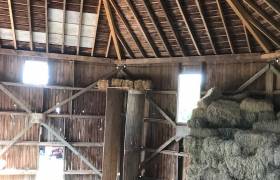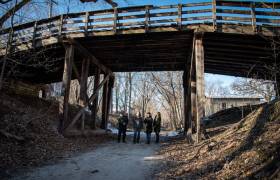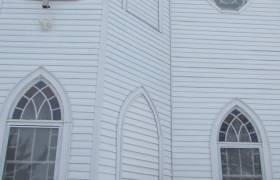Cruise on over to this celebration of of...
Conservation demands we save the family farm
Published Feb. 1, 2016 in the Northwest Herald
When the conservation of a natural woodland or vista butts up against the need to conserve historic structures, which emerges unscathed? Ideally, both do.
Each are unique examples of a bygone era continuously under threat from development. Each have untold cultural significance, speaking to who we were, are and hope to become. Each are irreplaceable and represent a valuable legacy for future generations.
To its credit, the McHenry County Conservation District Board of Trustees recognizes this. It will host a daylong Conservation Congress event Feb. 6 at McHenry County College. Delegates from a number of organizations, including the McHenry County Historical Society & Museum in Union, will be attending. The objective is to provide a process whereby interested parties can propose and advocate for actions that will best position MCCD’s mission of protecting and conserving our natural resources during the next 50 years.
In its declaration of fundamental conservation principles, the conservation district states – among other things – that:
“The public lands of McHenry County, protected by the McHenry County Conservation District, are an irreplaceable natural and cultural legacy that should be passed on to future generations in sound ecological health for public use and enjoyment and for their own intrinsic value.”
And that “differing user groups should be united in support of the larger goals of protecting the public lands of the district from misuse, environmental degradation, resale, transfer or conversion to other uses that destroy or diminish the ecological, cultural, historic, aesthetic and recreational values for which they were preserved.”
Of course, the actions behind these words are what matters. And I’m pleased to say that MCCD has made significant strides in that direction. The McHenry County Historic Preservation Commission recently landmarked the district-owned Powers-Walker farmhouse – an 1854 Greek revival house being restored in Glacial Park. Other volunteers are working to reclaim Richmond’s McConnell farm and there has been progress made at the 116-acre Camp Algonquin – although, admittedly, not as much as I had hoped. Four of the 47 structures have received a reprieve from demolition – a turn-of-the-century dairy barn, a counselor’s cabin, one of three Tribune dormitories and a portion of the recreation building.
Ironically, the Lake County Forest Preserve is confronting a similar situation at its 2,805-acre Lakewood site in Wauconda – which also hosts the Lake County Archives and Discovery Museum. On its website the forest preserve takes credit for setting “the standard in nature and historic preservation. …”
The facts suggest otherwise.
A plan is under way to transfer ownership of the celebrated, 400,000-item Curt Teich Postcard Archives to the University of Illinois or to the Newberry Library in Chicago – a unilateral decision designed to save the district some $800,000 as part of a forced relocation of the Lake County museum to Libertyville.
And that is just the half of it. The entire complex of historic buildings that once constituted Lakewood Farms, some of which were used by the museum since 1976, could be razed. That prompted Ela Township Historical Society president Nancy Schumm to petition Landmarks Illinois for the farm’s inclusion on the state’s Ten Most Endangered list.
“They’ve been making excuses but they haven’t been preserving it along the way,” Schumm said. “This is their responsibility. To ignore it and then wait long enough that it becomes cost prohibitive to do the work is irresponsible.”
Chicago contractor Malcolm Boyle built the farm around 1937 to showcase his Guernsey cows. Designed by Synnestvedt Co., the farm featured a complex of 16 buildings, a manmade lake, orchards, gardens and a legacy that lingers to this day. In 1953, Boyle’s Guernsey “Hagan Farms Merry Song” won a prize at the International Dairy show. The cow produced 15,000 pounds of milk the previous year!
Lake County historian Diana Dretske said Boyle was at the tail end of a movement, from the 1870s to 1920s, in which influential Chicagoans swapped city life for green acres. One of the existing buildings Boyle improved was a pre-Civil War house, adapted in 1986 to house the Curt Teich archives.
“It tells a unique side of the collar county history with wealthy industrialists coming out to play farmer,” she said. “Even Marie Antoinette had her hamlet that she could retreat to and play farm girl.”
In July 1961, Howard Quinn, owner of a savings and loan in Chicago, bought the 1,250-acre farm and set about improving the operation. He constructed a huge metal building to house cows waiting to be milked. Torn down in 2010, the Chicago Bears once practiced there before the team built a permanent facility in Lake Forest.
After Quinn was convicted in 1965 of defrauding the government, the property was sold as restitution to the forest preserve. Some buildings housed equipment and the prize bull barn was adapted to serve as the museum lobby and gift store.
“The architecture is quite beautiful when you see it,” Dretske said. “These were upscale agricultural buildings. A lot of pride and money was put into it. It was a showplace.”
However, several farm structures already have been razed and others could follow suit once the museum heads to Libertyville. Schumm believes it should be kept intact and used, as in the past, during Lake County’s annual Civil War re-enactment.
A living farm, artists’ enclave, meeting hall and community center are other worthwhile ideas.
“In the context of all the buildings together, it is the only surviving gentleman farm open to the public in Lake County,” Dretske said.
Let’s hope she still can say that six months from now.
 © 2025 MCHS- All Rights Reserved.
© 2025 MCHS- All Rights Reserved.















